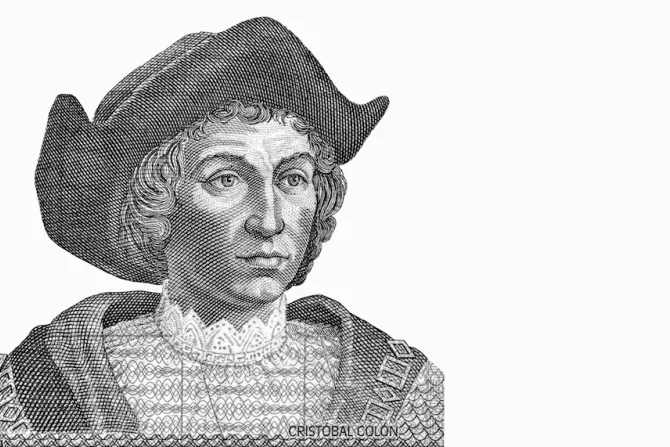Washington, D.C. Newsroom, Jun 18, 2020 / 23:00 pm
A Catholic high school in Wisconsin will not change its name from "Columbus Catholic High School" after a petition from alumni and other members of the community requested the change. But with Columbus statues coming down in cities across the country, one expert says the explorer has been mischaracterized.
The Wisconsin petition, which was started by three recent graduates of the high school, demands that the name of the school be changed and that a statue of Christopher Columbus be removed from the front of the school.
The petition charged that Columbus "acted in deeply racist ways," mistreated and enslaved indigenous people, and "represents racism and hatred."
But David Eaton, the president of Columbus Catholic Schools, explained in a letter several reasons why the schools would not be changing their name. Eaton's letter was initially published on a Facebook page for alumni of the school, and was subsequently re-published in local media.
Columbus Catholic Schools includes two schools--Columbus Catholic High School and Columbus Catholic Middle School--both named after Christopher Columbus.
The reason the schools were named, Eaton explained, was not out of blind admiration for the 15th-century Italian explorer. Rather, it was done to honor the people who funded the construction of the school - local Knights of Columbus.
"Like all histories, the history of Columbus Catholic Schools is long and somewhat complicated," Eaton began his letter. He explained that in 1882, the first Catholic church in the town of Marshfield, Wisconsin was completed, with the city's first Catholic school coming six years later.
In 1915, the Knights of Columbus chartered a council in the town, and the area's Catholic population grew until it became clear there was a need for a new high school.
"Which brings us back to the Knights of Columbus," Eaton wrote. "The KCs played a role in funding the construction of the new school. While each parish, and private donors, also made significant contributions to Columbus High School, the support of the Knights of Columbus was critical."
As a sign of the school's history and ties with the Knights of Columbus, the school's mascot was at some point changed to the "Don"-- a term which refers to a Spanish or Italian noble.
"The mascot, therefore, is quite literally a "Knight of Columbus," said Eaton.
"Those who chose the name likely did so more to honor the help and legacy of the Knights of Columbus than to honor Columbus the man. Like Father McGivney, they hoped to provide a place for Catholics to escape from the prejudices they faced in secular society even at that time," he said.
While Eaton acknowledged that Columbus is not today universally regarded as a positive role model, one expert on the explorer has written that Columbus is frequently mischaracterized or misunderstood.
Columbus, cultural anthropologist Carol Delaney told CNA in 2017, has been "terribly maligned."
"I think a lot of people don't know anything much, really about Columbus," said Delaney, an anthropology professor emerita at Stanford University and the author of the 2011 book "Columbus and the Quest for Jerusalem."
In 1492, the explorer, as American schoolchildren are taught, sailed the ocean blue.
(Story continues below)
But contrary to popular belief, Delaney said Columbus had a favorable impression of many of the Native Americans he met, and instructed the men under his command not to abuse them, but to trade with them. At one point Columbus hung some of his own men who had committed crimes against native people.
Columbus was not hell-bent on genocide, slavery, and rape of the native population he encountered in his travels, Delaney told the Knights of Columbus in 2017. In fact, the explorer was deeply religious, and hoped to evangelize the indigenous people in America, by teaching the Catholic faith.
"His relations with the natives tended to be benign. He liked the natives and found them to be very intelligent," she said.
"He also described them as 'natural Christians' because they had no other 'sect,' or false faith, and believed that they could easily become Christians if they had instruction."
"When I read his own writings and the documents of those who knew him, he seemed to be very much on the side of the Indians," Delaney added in a 2017 interview with CNA.
"They're blaming Columbus for the things he didn't do. It was mostly the people who came after, the settlers," she added.
The call to rename Columbus Catholic High School comes at a time when statues of many historical figures--including Columbus--have been taken down by protestors and rioters.
One statue of Columbus was removed from the grounds of the Minnesota Capitol in St. Paul. The statue, which was created by an Italian-American and was intended as a show of support for the Italian immigrant population of Minnesota, was toppled on June 10.
No charges have been filed against the people who brought down the statue.
Jason Adkins, executive director of the Minnesota Catholic Conference, told CNA that the statue's fall is a sign of "negligent failure by public officials."
"We cannot allow persons or activists of politically favored groups to destroy property, public or private, simply because an object or building causes offense," Adkins said in a statement to CNA.
"The celebration by many in the community of the statue's lawless removal also shows the prevalence of fake history. Columbus is not a canonized saint, but he is not a villain, either. As described by Pope Leo XIII, his motives were exemplary, and it was an extraordinary achievement to connect the peoples of two hemispheres. To say Columbus was a perpetrator of genocide makes a mockery of the term," he added.
Adkins said that he had "made inquiries" for a transparent process on restoring the statue to its previous location.
"The statue should be restored to public view," he said.



